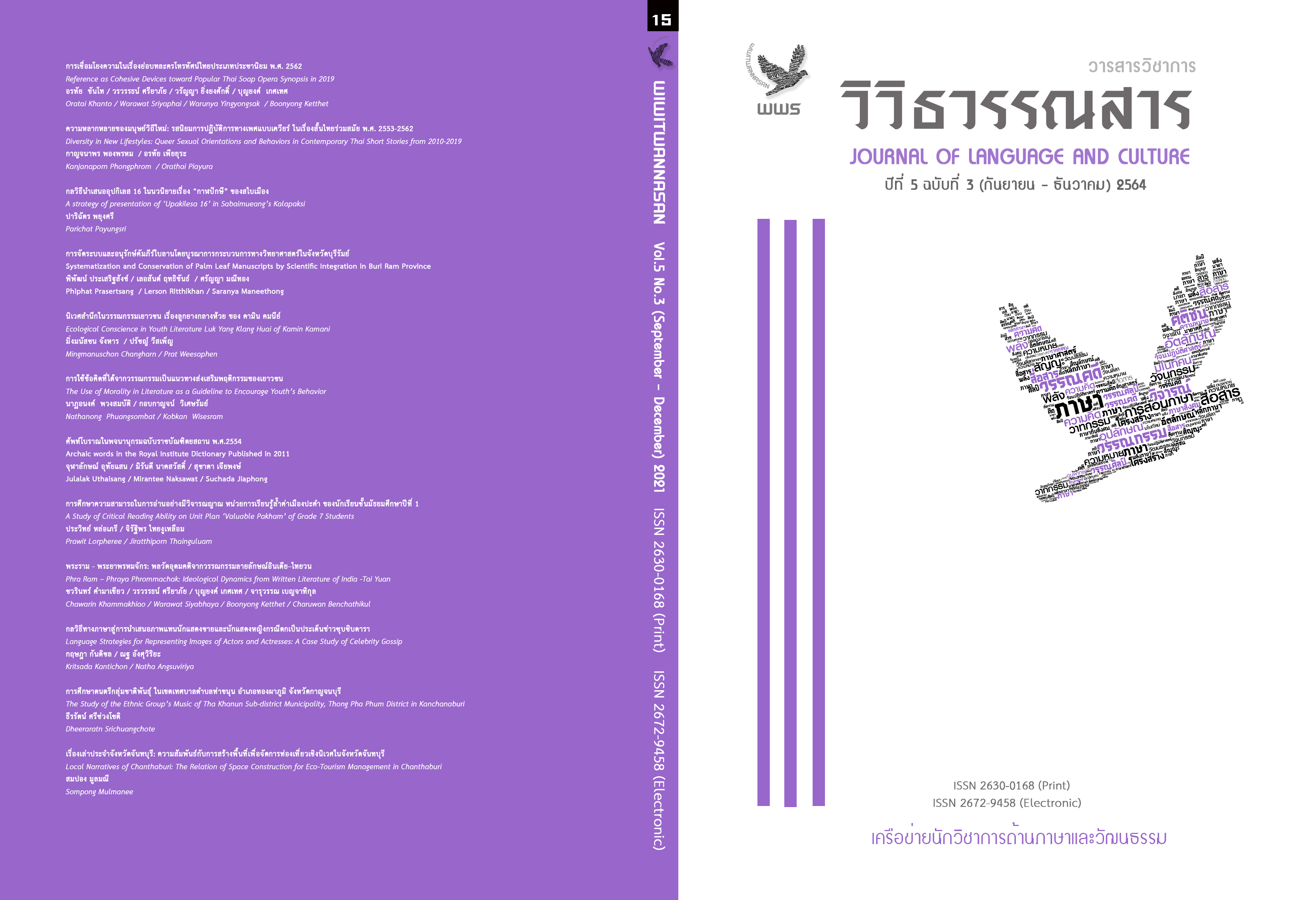Local Narratives of Chanthaburi : The Construction for Eco-Cultural Tourism Management
Main Article Content
Abstract
The research on Narratives Chanthaburi Construction for Eco-Cultural Tourism was conducted with the objectives of collecting and studying local narratives of Chanthaburi province and studying the process of managing eco-cultural tourism based on local narratives. The researcher applied the concept of Myth and Narrative Studies, Cultural Ecology, and Creative Folklore to analyze the narrative data that appeared in 6 districts of Chanthaburi province where the most popular eco-cultural attractions appeared: Mueang district, Laem Sing district. Khitchakut district, Tha Mai district, Makham district and Khalung district.
The results of the study revealed that local narratives related to the creation of eco-space in Chanthaburi province were in total of 41 versions, which were classified into types of narratives explaining the creation of natural spaces in 9 versions, narratives explaining the home, city, and sacred people in 20 versions, narratives explaining traditions and rituals in 4 versions and narratives explaining Buddha’s images and objects in 8 versions. It was found that the role of local narratives used to create eco-cultural space for tourism management was categorized in 3 aspects: 1) creation of the identity of Chanthaburi people with local narratives for cultural tourism management 2) narratives of rituals, beliefs, and traditions to tourism management and 3) creation of value for natural attractions with sacred stories.
Article Details
Copyright is that of the journal any reproduction must be permitted by the editor of journal
References
ร้อยเอ็ด” ใน วารสารวิถีสังคมมนุษย์. ปีที่ 5 ฉบับที่ 2 กรกฎาคม -ธันวาคม. 167-189.
ปฐม หงษ์สุวรรณ. (2553) อาณาบริเวณชายแดนแม่น้ำโขงกับกระบวนการสร้างความหมายในบริบทของ
สังคมสมัยใหม่ : กรณีศึกษาเรื่องหนองคาย – เวียงจันทน์. คณะมนุษยศาสตร์และสังคมศาสตร์
มหาวิทยาลัยมหาสารคาม:มหาสารคาม.
ปฐม หงษ์สุวรรณ. ( 2554) ตำนานพระพุทธรูปล้านนาพลังปัญญาทางความเชื่อและความสัมพันธ์กับ
ท้องถิ่น. เชียงใหม่. : แม็กซ์พริ้นติ้ง(สำนักมรดกล้านนา).
ปรมินท์ จารุวร. (2549) ความขัดแย้งกับการประนีประนอมในตำนานปรัมปราไทย. กรุงเทพฯ : โครงการ
ตำราคณะอักษรศาสตร์ จุฬาลงกรณ์มหาวิยาลัย.
ปรมินท์ จารุวร. (2559) คติชนกับการท่องเที่ยว: หมู่บ้านวัฒนธรรมหนองขาว จังหวัดกาญจนบุรี.
กรุงเทพฯ: โครงการเผยแพร่ผลงานทางวิชาการ คณะอักษร ศาสตร์ จุฬาลงกรณ์มหาวิทยาลัย
วิจิตร ว่องวารีทิพย์. (2550) การจารึกความทรงจำของท้องถิ่น: สิ่งที่ปรากฏในพื้นที่ศักดิ์สิทธิ์. วารสารไทยคดี
ศึกษา 4(1). 84-131
ศิราพร ณ ถลาง. (2557) ทฤษฎีคติชนวิทยา : วิธีวิทยาในการวิเคราะห์ตำนาน-นิทาน
พื้นบ้าน. พิมพ์ครั้งที่ 4. .พิมพลักษณ์ กรุงเทพฯ : สำนักพิมพ์แห่งจุฬาลงกรณ์มหาวิทยาลัย.
ศิราพร ณ ถลาง. (2562). คติชนสร้างสรรค์ บทสังเคราะห์และทฤษฎี. พิมพ์ครั้งที่ 2. กรุงเทพฯ: ศูนย์
มานุษยวิทยาสิรินธร.
ศรีศักร วัลลิโภดม. (2543). ความสำคัญของตำนาน [Myth] ที่ไม่ใช่เพียง "มายาคติ" วารสารเมืองโบราณ
33(1). 1
สายป่าน ปุริวรรณชนะ. (2552) ตำนานประจำถิ่นริมแม่น้ำและชายฝั่งทะเลภาคกลาง : ความสมานฉันท์ใน
ความหลากหลาย. พิมพ์ลักษณ์. กรุงเทพฯ : จุฬาลงกรณ์มหาวิทยาลัย.
สุทัศน์พงษ์ กุลบุตร. (2537) ประเพณีพิธีกรรมเกี่ยวกับพระธาตุศรีสองรัก อำเภอด่านซ้าย จังหวัดเลย.
วิทยานิพนธ์ ศศ.ม. ไทยคดีศึกษา: มหาวิทยาลัยมหาสารคาม.
อำคา แสงงาม. (2553) การศึกษาศักยภาพทรัพยากรและการจัดการท่องเที่ยวทางวัฒนธรรมโดยชุมชนเพื่อ
ส่งเสริมการท่องเที่ยว ในเขตทุ่งกุลาร้องไห้. วิทยานิพนธ์ ศศ.ม. ไทยคดีศึกษา: มหาวิทยาลัย
มหาสารคาม.
อมรา พงศาพิชญ์. (2549). ความหลากหลายทางวัฒนธรรม. พิมพ์ครั้งที่ 5. กรุงเทพฯ : จุฬาลงกรณ์
มหาวิทยาลัย
อนุกูล ตันสุพล. (2559). นิเวศวิทยาวัฒนธรรม : กุญแจสู่การพัฒนาที่ยั่งยืน. วารสารคณะมนุษยศาสตร์และ
สังคมศาสตร์ มหาวิทยาลัยสงขลานครินทร์ วิทยาเขตปัตตานี.12(1).194-221
อภิลักษณ์ เกษมผลกูล. (2556). เรื่องเล่าพื้นบ้านกับการสร้างมูลค่าเพิ่มแก่ผลิตภัณฑ์ และการท่องเที่ยว
ท้องถิ่นในภาคกลาง:มิติความสัมพันธ์ระหว่างปรากฏการณ์โหยหาอดีตกับเศรษฐกิจสร้างสรรค์.
วารสารอักษรศาสตร์ 42(2). 103-132


